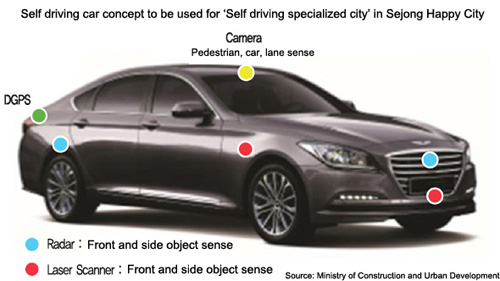Sejong city to speed up ‘self driving specialized city’ change…3D detailed map development in process
Park Sang Gil | sweatsk@ | 2017-06-08 10:11:09

The construction of related infrastructures to make Sejong Happiness City a self-governing specialized city by 2020 is accelerating. By the end of the year, a self driving road of 33 kilometers will be constructed, and the information including the lanes, tunnels, bridges, medians, traffic lights, traffic signs, etc., will also be made.
According to the Ministry of Construction and Urban Development on June 7, the self driving roads will be expanded to 33km by the end of the year.
The newly constructed self driving roads will be constructed at 10 km around the Government Complex and within 23 km of the main arterial roads in the Bus Rapid Transit (BRT), and will be gradually expanded to 360 km, which is the entire section of the City of Happiness, by 2020.
Ministry of Construction and Urban Development is expected to develop self driving road to BRT road. This is to secure timeliness while reducing the uncertain environmental factors that the self driving car will travel while constructing in a completely separated space from ordinary vehicles and city buses.
By doing so, the uncertainty of the driving environment can be reduced and the intersection can be driven without any signal waiting time compared to the self driving possible roads implemented in Seoul. The self driving car can be driven first even in the driving section where the signal should be received.
Detailed road maps are also developed that includes various information which are required for self driving in addition to expanding the self driving roads. This map provides information on road facilities such as roads, stop lines and other necessary information required for self driving, such as a median barrier, tunnels, road signs and traffic safety signs and road signs within 25cm error range.
Besides, `Next Generation Intelligent Transportation System (C-ITS)` is also developed to provide drivers with dangerous road information such as traffic conditions, sudden stops, and falling objects in real time while driving self driving car. 3000 car terminals, 95 roadside bases, and 7 emergency detectors are applied to the system. There are 3,000 car terminals divided into head-up display type (200 units), navigation type (1,400 units), and smart phone type (1,400 units).
In head-up displays, the current speed of car, navigation, and fuel levels is illuminated on the front window of the car to help the driver see the display. The driver will be able to see the car information through the windshield and can maintain forward visibility while driving.
Ministry of Construction and Urban Development representative said, "When self driving roads are construction on BRT-only roads, self driving cars should travel along designated routes. Therefore, it is expected to be able to run more safely and autonomously, free of variables such as traffic accidents, intersections, etc."
By Park Sang Gil sweatsk@
